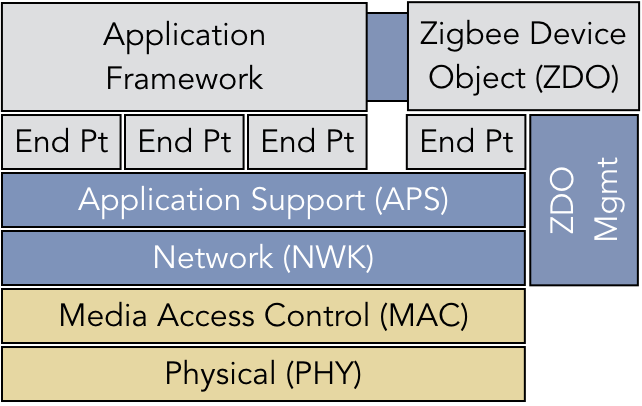5.7. Wireless Connectivity: Wi-Fi, Bluetooth, and Zigbee¶
We close our survey of network technologies with a brief overview of three forms of wireless connectivity that facilitate three very different capabilities. Wi-Fi is the common name for the set of wireless technologies defined by the IEEE 802.11 working groups and supported by the Wi-Fi Alliance. Bluetooth is a set of standards defined by the Bluetooth SIG. Zigbee is a suite of protocols maintained by the Zigbee Alliance, intended to create short-range networks using radio communication defined by the IEEE 802.15.4 working group.
5.7.1. Wireless Protocol Stacks and Uses¶
Wi-Fi is designed to act as a substitute for the wired connections that make up the traditional link and physical layers. That is, Wi-Fi assumes that the goal is to use a wireless connection to facilitate Internet access for a mobile device. As such, devices like laptops and tablets use the 802.11 technology standards to communicate with an access point that is connected to an ISP. Readers may be familiar with the different standards, such as 802.11a, 802.11g, and 802.11n. These standards offer different levels of performance by specifying different features of the radio that is used. For instance, 802.11n wireless routers can have more than one antenna to support multiple input and multiple output (MIMO) access; with MIMO, the router can be sending and receiving communications with several devices all at one, increasing the efficiency of the overall system. Early standards did not assume MIMO-compatible radios, so the maximum speed and throughput were significantly lower.
In contrast, Bluetooth was not designed to connect a device to the Internet. Instead, Bluetooth devices focus on short-range mobile ad hoc networks (MANETs). In a MANET, unknown devices establish connections with efficient, minimal overhead and configuration; the goal is to allow a new device to join the network rapidly, exchange some data, then disconnect. In the simplest case, Bluetooth speakers or headphones may be used to play the sound that would otherwise be produced by a computer’s speakers; similarly, a Bluetooth keyboard or mouse reduce the number of cables that must physically connect a computer and its peripheral devices. Bluetooth devices are generally assumed to have low-power requirements, so the range of the connection can be as short as 1 to 10 meters.
Since Bluetooth is not intended to provide Internet access, its protocol stack is very different than the 5-layer model we have examined previously. Figure 5.7.1 shows the main structure of the Bluetooth protocol stack. At the lowest layer, the baseband and the link manager/link controller (LM/LC) layers provide the basic point-to-point modulation of the radio signal. The logical link control and adaptation protocol (L2CAP) acts in a manner similar to the traditional link layer by multiplexing access to the radio for higher-layer protocols. Given Bluetooth’s usage model is for point-to-point communication, its protocol stack does not offer an equivalent of the Internet layer.
Bluetooth defines a number of protocols that are analogous to a transport layer. The RFCOMM protocol provides a generic serial port interface, similar to a TCP stream socket. Multichannel adaptation protocol (MCAP) defines a common transport layer for medical devices. Lastly, the generic access profile (GAP) creates an extendible interface that can be used for future applications that are not defined in the specification.
Bluetooth profiles serve as the equivalent of the application layer. The hands-free protocol (HFP) defines the interface for connecting a cell-phone to a wireless peripheral, such as a headset or an automobile. HFP and object exchange (OBEX)—a generic profile for exchanging binary data—run on top of the RFCOMM protocol. The health device protocol (HDP) provides a common interface for healthcare devices, such as thermometers or heart meters, running on the MCAP protocol. Some profiles, such as human interface device (HID) and audio/video distribution transport protocol (AVDTP), run directly on top of L2CAP to minimize their latency to support real-time human interactions. HID is used for wireless devices such as a mouse and keyboard, whereas AVDTP is used for devices like headphones. More recently, the advanced audio distribution profile (A2DP) has been added on top of AVDTP to provide improved service for audio-visual devices.
The Bluetooth SIG was established with a core set of applications in mind. The designers also had a stated design goal to use existing radios, rather than designing new technology from scratch. These design goals allowed the Bluetooth SIG to get devices on the market for consumer use very rapidly. By working within the constraints of the top and bottom layers (the applications and the existing radios), the designers were able to construct a working protocol stack in a short period of time.
The Zigbee wireless standard lies somewhere in between the goals of Wi-Fi and Bluetooth. Like Bluetooth, Zigbee is used for MANETs, but on a larger and more complex scale. To be specific, Bluetooth is generally based on a star topology, with multiple peripherals (keyboard, mouse, speakers) connecting to a central device (laptop); no one expects their keyboard and mouse to be exchanging data packets. In contrast, Zigbee provides support for wireless mesh networks, in which devices provide support for routing packets if two hosts are too far apart to communicate directly. Note that the Internet backbone can be described as a wired mesh network, allowing multiple routing paths; Zigbee takes this idea and replaces the wired connections with wireless ones. Zigbee uses this structure to support applications like low-powered sensor networks. Zigbee is one of the protocols used to support the Internet of Things (IoT). IoT is the general concept of connecting non-traditional computing devices, such as home appliances, thermostats, or entertainment devices, to each other and to the Internet as a whole.
Figure 5.7.2 shows the structure of the Zigbee protocol stack. The lowest layers, MAC and PHY, are defined by the 802.15.4 working group, independent of Zigbee itself. These layers define a generic point-to-point communication that can be used with low-power radios. Zigbee refers specifically to the layers built on top of this this foundation. The NWK layer coordinates the mesh routing that builds the network. The APS and Zigbee Device Object (ZDO) Management provide common services that applications can use, such as cryptographic key management and information about devices on the network. Applications can access ZDOs through an interface at the application layer, or they can request services through application end points.
These three protocol stacks serve illustrate how wireless connectivity can be used to provide very different services. Wi-Fi is designed to extend the traditional Internet model to mobile devices, replacing the last link of the network with a wireless access point. Bluetooth defines a local point-to-point mechanism that allows computer peripherals to communicate without a cable physically connecting the devices. Zigbee creates a wireless mesh network that can be used to route data, such as sensor readings, between low-powered devices. Zigbee devices can also have additional components added that allow them to link to an Internet access point, connecting the sensor network and the Internet. These separate infrastructures provide support for application designers to build services that can communicate without physical connections.

